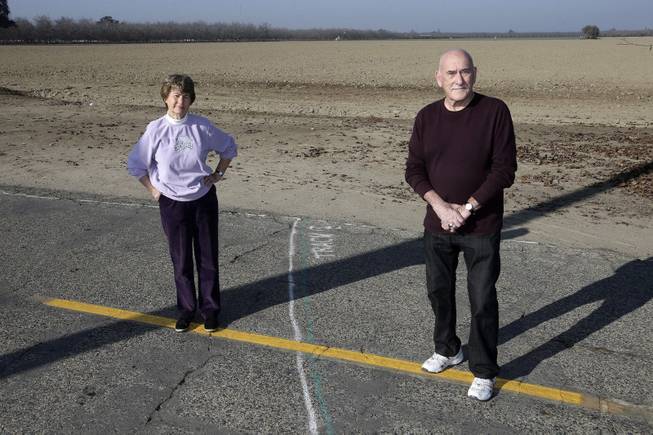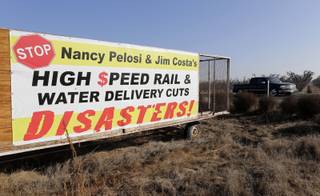
Gary Reyes/Bay Area News Group / MCT
Phyllis and Ross Browning stand alongside a line drawn across Cairo Avenue marking the path of the proposed high-speed rail through their Hanford, Calif., neighborhood, Dec. 12, 2013. The proposed rail line will run a few houses away from their residence. The couple moved to Hanford in 2005 to retire and live next door to Phyllis’ mother.
Monday, Jan. 27, 2014 | 2 a.m.
HANFORD, Calif. — A large grove of walnut trees and a small river border the property where Phyllis and Ross Browning live in this Central Valley city that hasn’t changed much since her childhood. Cherries, almonds and winter wheat still fill fields across town, and the scent of manure from dairy cows is unmistakable on a warm day. An old-fashioned ice cream parlor has anchored downtown for nearly a century.
Visalia, 20 miles to the east, shares some of that charm. But business and political leaders there are less resistant to change and say they want their city to grow and prosper. Heated disagreements over the $68 billion bullet-train project, designed to bring the state together, are tearing the two towns — and much of the Central Valley — apart.
“Farmers see the project as a big government boondoggle that will harm their way of life,” said Thomas Holyoke, an associate professor of political science at Fresno State. “Urban areas desperate for a little economic growth see it as a rare opportunity. There’s a clear divide.”
In Hanford, two farmers leading a court battle against the project have become local celebrities, and the anti-bullet-train lawn signs they distribute dot yards across town.
In Visalia, city leaders envision the train zipping residents to college classes and big-league sporting events in the Bay Area and the Los Angeles region. Locals, they predict, also will take the train to work and reduce the valley’s staggering jobless rates.
The California High-Speed Rail Authority’s planned line is the same one that supporters of Las Vegas-based XpressWest want to link to in Palmdale, Calif., establishing rail service between Las Vegas and downtown Los Angeles.
XpressWest is mired in its own bureaucratic issues. Planning for a line between Las Vegas and Victorville, Calif., and Victorville to Palmdale has stopped because it is backed mostly by foreign investors and a federal loan the company is seeking doesn’t comply with the program’s “Buy American” requirements.
In addition, Republican political leaders believe the loan would never be repaid and have blocked efforts to fund it.
Almost everyone in Hanford, from homeowners to City Council members, thinks the bullet train will permanently damage the town of nearly 55,000. But city leaders in Visalia, a more bustling city with a population of more than 127,000, say they know the train is going to be built whether the valley wants it or not — and supporting the project positions the town to gain the most from its construction.
“It would be a disservice to our children and grandchildren if we don’t do everything we can to make sure a rail station gets built nearby,” said Mike Olmos, Visalia’s city manager.
The high-speed project suffered a serious setback last month when a Sacramento judge rejected a request from the California High-Speed Rail Authority to sell $8.6 billion in bonds, saying officials needed to show how they will pay for the first 300 miles of construction, from Merced to the San Fernando Valley. But rail officials are pushing ahead, saying they will spend as much as $3.3 billion in federal funds to begin the rail line. And if construction starts in several weeks as planned, hundreds of Hanford homes and businesses will eventually be razed. The Brownings’ house is one of them.
“I can’t relax and enjoy life anymore with this thing hanging over our heads,” said Phyllis Browning, 70, who moved back to Hanford to retire after working as a secretary in San Jose for four decades. “I feel depressed all the time.”
If the 800-mile rail line is eventually completed in 2029, as now scheduled, it will make stops in four valley towns, including Hanford, even though Visalia was the one that begged for a station.
Lifelong Hanford residents John Tos and Aaron Fukuda first learned a few years ago that the 220-mph train might barrel through their properties.
Tos received a form letter from the rail authority, while Fukuda’s official notification came on a small, glossy postcard with a tiny image of the rail line’s path. At first, Fukuda, 37, thought it was junk mail.
Months later, he learned the train was set to swallow the property where he and his wife wanted to build their dream home and start a family.
Tos, 72, is a fourth-generation farmer who still tends his almond, walnut and table grape crops every day. The bullet train’s latest construction plans show the tracks running through the shop where Tos processes his crops. It also will cut him off from a portion of his farmland.
The state has promised to fully reimburse property owners, but Tos said that’s not possible.
“It’s not about the money,” he said. “It’s about the crops and the land that are our livelihood.”
He and Fukuda lead a nonprofit group called California Citizens for High Speed Rail Accountability, and they frequently trek to Sacramento to voice their concerns at the authority’s monthly meetings. The lawsuit Fukuda and Tos filed against the state resulted in the recent court ruling that has left the project hanging by a thread.
Fukuda calls the Visalia officials who support the rail line “unneighborly, to put it kindly.”
He and Tos say it’s common for people to interrupt their lunches or pull them aside at the grocery store to thank them for their hard work.
“People stop me all over town and ask, ‘How can we help?’” Tos said. “This community has never been so charged up.”
Jeff Morales, the rail authority’s CEO, acknowledged that the havoc Hanford’s frustrated residents have wrought on the project might have been avoided if the state had shown them more respect from the beginning. Hired in 2012 to run the project, Morales said the authority did a poor job communicating with people in Hanford and other valley towns about how construction of the rail line would affect their lives.
He said the authority now has a small team of people on the ground in Hanford who walk door to door, offering to answer residents’ questions.
Supporters of the train note that unemployment in some Central Valley farm towns is as high as 17 percent, a figure that’s more than twice the national average.
Most Visalia leaders say they agree with rail officials that the project will bring the region planning, engineering and construction jobs now — and access to jobs in Los Angeles and the Bay Area later. It will ease congestion on the two main highways that run through the valley and improve the region’s air quality, supporters say.
“We support this train because we don’t want to watch it go by without us,” said former Visalia Mayor Amy Shuklian, one of the rail line’s biggest fans.
Downtown Visalia has a bus depot geared toward commuters, but many people are out of work. Few residents have college degrees, and teen-pregnancy rates are sky high.
With access to the state’s business and cultural hubs a short train ride away, Olmos, the city manager, thinks all of that can change.
Coupled with its high poverty, the region also has high rates of diabetes and obesity. But when local doctors urge patients to visit specialists in Los Angeles or the Bay Area for more advanced care, Olmos said, they often don’t go because they can’t afford the gas and the drive is too far for most people.
Many Visalia residents argue that the rail project will make valley life less isolating.
“I just took a trip to Paris, and we visited Versailles on a high-speed train,” said Crystal Burchnell, 63, an office assistant. “It’s an awful long drive to San Francisco, but if I could get there on the train more quickly, I’d go more often.”
To be sure, not everyone in Visalia loves the idea of a bullet train. Some worry that it will leave the valley with a train to nowhere if construction is started but never completed.
“This train will bankrupt California,” said Floyd Hager, 42, a welfare fraud investigator for Tulare County. “And I don’t see mass numbers of people boarding it. I just don’t see it.”
Even Olmos concedes that beginning bullet train construction in the valley has been a mixed blessing. He said he regrets that Visalia’s hope for a more prosperous future has caused such hard feelings — which could linger in Hanford and Visalia long after the rail line is built.
“It’s troubling that a project with so much promise has caused so much heartache for our neighbors,” Olmos said. “Some days, I have to work hard to maintain my enthusiasm.”
Sun reporter Richard N. Velotta contributed to this story.


Join the Discussion:
Check this out for a full explanation of our conversion to the LiveFyre commenting system and instructions on how to sign up for an account.
Full comments policy